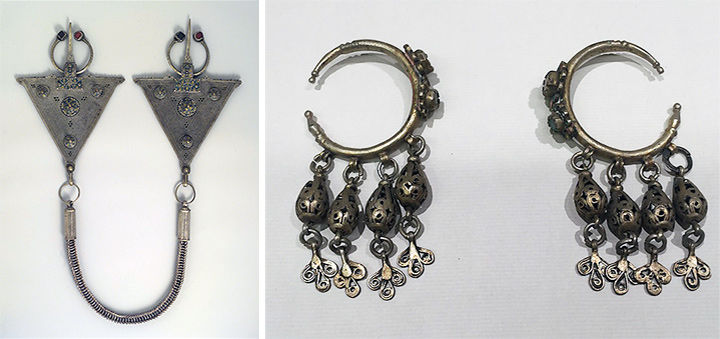
Black History Month Spotlight: Ancient African Jewellery
Share
As jewellery continues to evolve across cultures and generations, one thing remains a constant truth: it will always be an important part of society. In honour of Black History Month, we are excited to share what we’ve learned about ancient African jewellery in particular.
In addition to simple adornment, jewellery was used all over the continent for both spiritual and physical protection, and to convey wealth, marital status, or societal position. Jewellery was also seen as an investment that could be sold in times of financial hardship.
SHELLS
The earliest examples of African jewellery are a set of small shells found in 2004 in the Blombos Cave of South Africa, dated at 75,000 years old. These shells were from the tiny mollusk Nassarius kraussianus, each one featuring holes punctured in the same place and showing signs of wear as if they had been strung together. There were also traces of red ochre on the beads, suggesting that they might also have been coated in the colourful iron oxide pigment. This discovery actually demonstrated that African humans of that time period were more culturally advanced than previously thought.
 Mollusk shells dated at 75,000 years old, found in the Blombos Caves of South Africa. Image: Marian Vanhaeren/Francesco d'Errico (Courtesy of NewScientist.com)
Mollusk shells dated at 75,000 years old, found in the Blombos Caves of South Africa. Image: Marian Vanhaeren/Francesco d'Errico (Courtesy of NewScientist.com)
While other African jewellery materials include porcupine quills, bones, animal teeth, wood, ivory, stone, and various metals, it's ostrich egg and cowrie shell that are among the oldest and most-used materials.
 Ostrich shell beads dating to 700–500 BC. Image: Pitt Rivers Museum
Ostrich shell beads dating to 700–500 BC. Image: Pitt Rivers MuseumIn addition to being a symbol of female fertility, cowrie shells were also used as currency, representing wealth and power all over Africa - and all over the world - until well into the 20th century. According to Simon-Hartman.com, the Ghanaian word “cedi”, which is the name of Ghana’s currency, is actually derived from the Fanti word for “cowries”.
SILVER
In Algeria many women of the semi-nomadic Ouled Naïl tribe became dancers, developing a unique style of bellydance called Bou Saâda and travelling to various towns as entertainers to earn money for their families. These performers often wore spiked silver Swar bracelets to protect themselves from over-enthusiastic clients and potential thieves alike.
Gold is considered bad luck in both the Tuareg and Berber cultures of the Sahara, so silver is the most common metal used for jewellery in these areas.
Examples of ancient Berber pieces seem to be rare because items are typically melted down to make jewellery designed specifically for the wearer. One surviving example, however, is the fibula - a large piece of jewellery worn across the chest to hold capes and other articles of clothing in place.

A Moroccan woman wearing a pair of fibulae at the beginning of the 20th century. Image: Wikipedia
Tuareg items in particular tend to feature bold geometry, and the Tuareg Cross amulet is no exception (though it is important to note that the term "cross" was attributed by Europeans and the item itself is unrelated to Christianity). The silver pendant was passed from father to son with the words, “I give you the four corners of the world, because one cannot know where one will die.” There are approximately 21 different styles of Tuareg Cross, each representing a different location of origin.
 Tuareg Crosses. Image: Amazigh.it
Tuareg Crosses. Image: Amazigh.it
GOLD
In Egypt on the other hand, gold seems to have always been a huge part of the culture. In fact, some historians believe that the discovery of gold directly contributed to the rise of jewellery’s popularity in the area. Although much looting (and the subsequent melting down) of gold from ancient sites has occurred over time, the earliest surviving jewellery items date back to the fourth millennium B.C. and consist mostly of beads and other small items like the small gold bracelet at the Metropolitan Museum of Art, featured below:
Gold jewellery in this region was often embellished with lapis lazuli, carnelian, and turquoise, as their colors were of particular cultural significance. In some cases, jewelry simply featured a combination of coloured glass to represent each of these stones’ colors.

Hinged cuff bracelet from ancient Egypt featuring carnelian and glass that was once coloured deep blue and turquoise, circa 1479–1425 B.C. Image: Metropolitan Museum of Art
King Tutankhamun’s death mask is yet another example of how important both gold and the three colors were to ancient Egyptian society. The gold mask is inlaid with lapis lazuli, carnelian and turquoise, as well as quartz, obsidian, amazonite, and pieces of coloured glass.

King Tutankhamun's death mask, circa 1323 B.C., photographed by Roland Unger. Image: smarthistory.org
Senegal is another country where gold has played an important cultural role for centuries. According to The Smithsonian Institution, Senegalese goldsmiths have been crafting intricate, elaborate jewelry since at least the 11th century in styles that incorporate techniques such as filigree, granulation, gilding, hammering (goldbeating), and wire drawing.
Much like the Berbers, Senegalese artisans also tend to melt down older pieces to form new ones. While few ancient Senegalese pieces are known to have survived, one fantastic example is the Rao pectoral from a 12th century archeological find:
Historian Marian Ashby Johnson has made it a personal mission to try and preserve Senegalese gold jewellery, and her collection was recently displayed in The Smithsonian Institution exhibit Good as Gold: Fashioning Senegalese Women. While most of these items are from the 19th and 20th centuries, the intricate style can be seen in items like the bicone pendant and butterfly necklaces below:

Butterfly necklace from Senegal. Image: The Smithsonian Institute
Skyjems specializes in custom jewellery and we would love nothing more than to make your dreams a reality! In the meantime, here are two of our finished pieces featuring gemstones from Africa:
|
|











